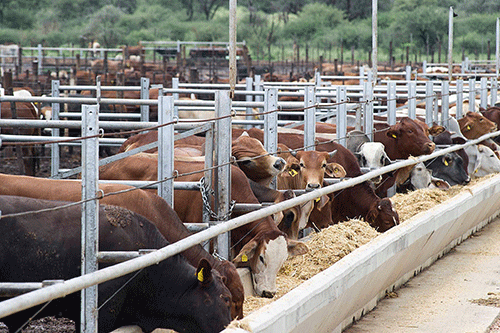The decision by most farmers countrywide to destock their cattle and other small livestock has spiked an increase in the country’s live cattle export market, which saw over 57 415 cattle exported since the start of the year.
Live cattle exports are currently 71.30% higher when compared to the exports of March 2023, while export abattoirs recorded a slaughter growth rate of 93.65% on a month-to-month basis since the beginning of 2024.
On a year-to-year basis, export abattoirs recorded a growth of 28.17%, while the local abattoirs recorded a decrease of 52.36% on a year-to-year basis.
Cattle marketing during the first quarter of this year increased
significantly due to the severe drought conditions nationwide, as farmers across the country are destocking their cattle to run efficient enterprises and avoid overgrazing.
Up to 99% of exported cattle, predominantly weaners, were destined for South Africa, and the remaining 1% was split between Angola and Botswana.
The majority of cattle exported to South Africa went to feedlots, whereas exports to the rest of SADC were exported for farming (breeding) purposes.
Overall, year-to-date cattle marketing has increased by 49.0%, with 27 983 cattle marketed during February 2024 alone, while year-to-date beef imports dipped by 74.6%.
On the other hand, beef exports grew by 78.6% on account of good slaughter activity by export-approved abattoirs.
More than half of beef exports recorded in February 2024 went to the EU, whereas the remainder went to the UK, Norway, South Africa and
Angola.
Remarkably, for the first time since July 2020, the Livestock and Livestock Products Board of Namibia has shared that the country managed to export its first beef consignment to the USA in February 2024.
Increased goat, sheep exports
The country witnessed an upward
trend in live sheep exports, which increased on a month-to-month basis by 64% from the 48 242 heads exported in February to 79 033 heads exported in March.
Furthermore, export and local abattoir slaughtering increased by 17% and 13%, respectively, with the majority of the exports in March (98%) going to South African abattoirs, while the remaining 2% were exported to Angola during the period under review.
Slaughter at export abattoirs, however, declined by 41% on a year-to-year basis.
Meanwhile, a total of 9 175 goats were exported live in March this year, which is a 21.23% increase on a month-on-month basis.
This shows a notable increase in live exports since the start of the year.
South Africa makes up 98% of the total live goat exports from Namibia, followed by Zimbabwe and Zambia at 1% each.
The overall exports of live goats increased to 7.35% on a year-to-year basis.
Goat lamb and goat ewe auction prices decreased to 11.54% and 3.47% on a year-to-year basis, respectively.
However, the goat kapater and ram increased by 4.22% and 20.81% on a month-to-month basis, respectively.
-ohembapu@nepc.com.na


